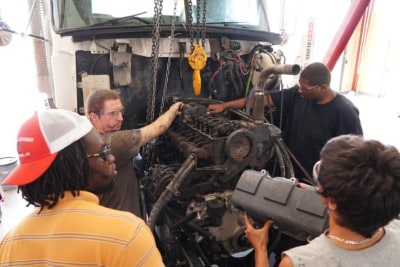At all levels of the education system, schools are beginning to ask themselves: What are we educating students for? For years, community colleges have educated students for an associate degree, an affordable alternative to a four-year degree or a stepping stone to one. In North Carolina, courses for students pursuing a two-year associate degree are called “curriculum courses,” and stand-alone classes designed for specific skills, but not part of a broader degree program, are called “continuing education courses,” or con ed. The funding model reflected this mission; the funding formula gave colleges more money for curriculum courses than con ed courses.
But with full-time enrollment in degree programs on the decline, community colleges are creating more avenues for workers to get the skills they need to advance their careers while working. And in an economy increasingly reliant on digital and technical capabilities, the skills taught in con ed courses are increasingly necessary for the workforce. Now, the North Carolina Community College System is asking that the funding model reflect this reality.
North Carolina’s community college funding formula
Funding for community colleges is comprised of four primary sources: state funding, local funding, tuition payments, and foundation funding. In North Carolina, state funding represents a larger portion of total funding than most other states. This commitment by the state to fund community colleges has allowed in-state tuition in North Carolina to remain one of the lowest rates in the country.
State funding is an intricate process with many components, but enrollment is by far the most meaningful. In 2018-2019, funding based on enrollment accounted for 83% of total funding allocated to community colleges. The state bases funding on full-time equivalents (FTEs), which measure the number of course hours taken by the student body in a given year. The more course hours taken, the more funding received.
However, not all FTEs are created equal; the State Board long defined one FTE as 512 hours of curriculum courses, but required 688 hours of con ed courses to equal one FTE. This meant schools earned substantially less in state funding for every hour of enrollment in con ed courses compared to curriculum courses.
For more on state funding of community colleges, watch the video below.
The push to equalize funding for con ed and curriculum courses
Given the importance of enrollment to funding, the policies that govern enrollment calculations are at the forefront of every community college president’s mind. In recent years, the push to equalize funding for curriculum and continuing education courses has become a top legislative priority.
Until last year, the number of hours that constituted a full-time equivalent, or FTE, was different for curriculum students and continuing education students. For funding purposes, the State Board of Community Colleges defined one FTE as the equivalent of 512 class hours of curriculum courses and 688 hours for continuing education classes.
The split in FTE calculations between curriculum courses and these short-term workforce training classes meant community colleges were receiving less funding for every class hour taken of a welding class compared to class hours of a curriculum course such as organic chemistry. Many in the community college system, including Surry Community College President David Shockley, find this system unfair to both institutions and students.
“Oftentimes, you’ll hear everyone say college degrees are not for everybody, but the skills are,” Shockley said. “When you teach welding to a con ed student, you get funded at a lesser rate. And yet it would cost you the same for the instructor and for the equipment to do that short-term training for those individuals who just wanted to learn the skill and not get a diploma or a degree. So we lose money basically.”
Shockley is not alone in his frustration. The North Carolina Community College System (NCCCS) presented this same case to the General Assembly in 2018. NCCCS advocated for an investment in short-term workforce training by funding con ed courses that lead to an industry credential at the same level as curriculum courses. Based on historical enrollment data, NCCCS demonstrated that closing the gap would result in a 34% increase in FTE.
In May 2018, NCCCS was successful in securing a $14.6 million increase in state funding to close the gap between curriculum and continuing education in FTE enrollment calculations. However, only $6.4 million of that funding is recurring, meaning they will receive it every year. The other $8.3 million was a one-time increase. This year, the NCCCS is asking for another increase in funding for con ed courses, although the exact number will change depending on enrollment over the past year.
If the legislature does not approve the additional funding, the gap in curriculum and continuing education funding will resume for many courses and with it the same struggles. This is why Jennifer Haygood, NCCCS Chief of Staff and Executive Vice President, says parity funding remains their top legislative priority.
Under the old calculation, colleges were forced to use tactics that are counterintuitive and inefficient to simply chase funding.
“A lot of times, […] we would have to run con ed courses [as] curriculum, which means students would have to take a placement test; they would have to do reading skills, math skills to get into the curriculum degree-seeking program, and all they wanted to learn was a welding skill,” David Shockley explained. He argues that closing the gap gives them the freedom to run courses in a way that best fits the student population and the skill set of the faculty.
Colleges were also forced to offer classes such as welding as two different versions, one for con ed students and one for curriculum students. For faculty teaching both course types, this change is more common sense than innovative. William Beaver, Welding Technology Program Head at Stanly Community College, feels a professional obligation to teach all students to the same level, regardless of their enrollment status.
“I can only speak for welding really [but] the con ed classes and the curriculum classes are basically the same thing,” said Beaver. “You’re going over the same amount of material; you’re asking the student to master the same skill set that you would in the other.”
Many in the community college system believe equalizing funding for con ed and curriculum courses will not only make it easier for those already in the system but will also help boost enrollment.
“With this funding, colleges are able to provide the short-term workforce training options to a greater extent than they currently can,” Haygood explained. “And therefore, I think that they will have both the ability and additional incentive to offer programming that directly aligns with workforce needs, which I do believe, if they market it correctly, can be attractive to students.”
Another added benefit Shockley anticipates is higher student completion rates.
“It’ll also help our completion rates because we would force [students] into a degree or diploma program. They would take the core classes like welding and never take the rest of the required classes. And then they would go get a job,” Shockley said. “But for us, it would look like non-completers and to reporting bodies — to the federal government, state government, and our accrediting bodies — it looks like we are failing even though we gave them the skills [and] they got a better job.”
Parity funding can lay the groundwork for stackable credentials
Equalizing FTE funding rates for con ed and curriculum courses is also an important first step in creating a system that recognizes all courses taken by students, not just curriculum courses.
In 2010, in the wake of the Great Recession, the NC Community College System recognized the importance of helping students who left degree programs to pursue work but later returned rather than punishing them for “stopping out.” This review was part of an initiative called the Code Green Super Curriculum Improvement Project (CIP).
Code Green Super CIP charged a group of community college presidents with streamlining technology course offerings to eliminate redundancy and provide the basis for “stackable credits.” In a report issued about the project, the presidents “recognized that allowing students to earn short-term certificates that could be stacked until the requirements for a degree had been met would help lower the number of students who didn’t persist to earn a diploma or degree.”
The movement towards stackable credentials rejects the idea that curriculum courses are of more value to the student than con ed courses, especially in an economy increasingly reliant on technical skills. Instead, it pushes the idea that short-term workforce courses offer students the ability to pursue skills or a degree over a longer time, often while continuing to work.
In the eyes of individual colleges, funding these short-term courses at a higher rate is the first step to reaching students that require a more flexible schedule or do not intend to complete a full degree. For Shockley, parity funding will both stabilize enrollment funding and help the colleges better reflect the reality on the ground.
“Say someone takes one welding class,” Shockley explained, “and maybe it’s TIG welding, and then they get in there and decide they like it. And so then they would be able to effectively crosswalk and change over to a degree program without any penalty and having to go back and repeat courses. So it’s also more efficient for the college and/or the student to have what we call stackable credentials.”
“We want to give credit to students where credit is due,” said Jennifer Haygood. Stackable credits, as well as other tactics described as Credits For Prior Learning, are all based around the idea that the system should allow students to gain credit for all types of classes and experiences that result in similar outcomes. “When [students] demonstrate competency with the learning outcomes that a course would otherwise cover, then we don’t believe you should have to pay and retake the course,” Haygood explained.
Haygood knows that work remains to be done to ready the community college system for such a change.
“We are also creating a structure by which we evaluate continuing education courses and then articulate that course to academic credit. And we want to put a structure in place such that it’s consistent across the system,” said Haygood. “If we don’t have the appropriate structures in place, students won’t be getting the academic credit that they need to move forward in their program of study.”
Sustained parity funding for con ed and curriculum is therefore a big first step in expanding how community colleges evaluate and reward prior learning and increase flexibility to the benefit of students.
This is the first part of a series looking at how community colleges help develop North Carolina’s workforce. The rest of the series will look at three specific programs: truck driving at Caldwell Community College and Technical Institute, enology and viticulture (winemaking) at Surry Community College, and the electrical lineman program at Cape Fear Community College.
Recommended reading



